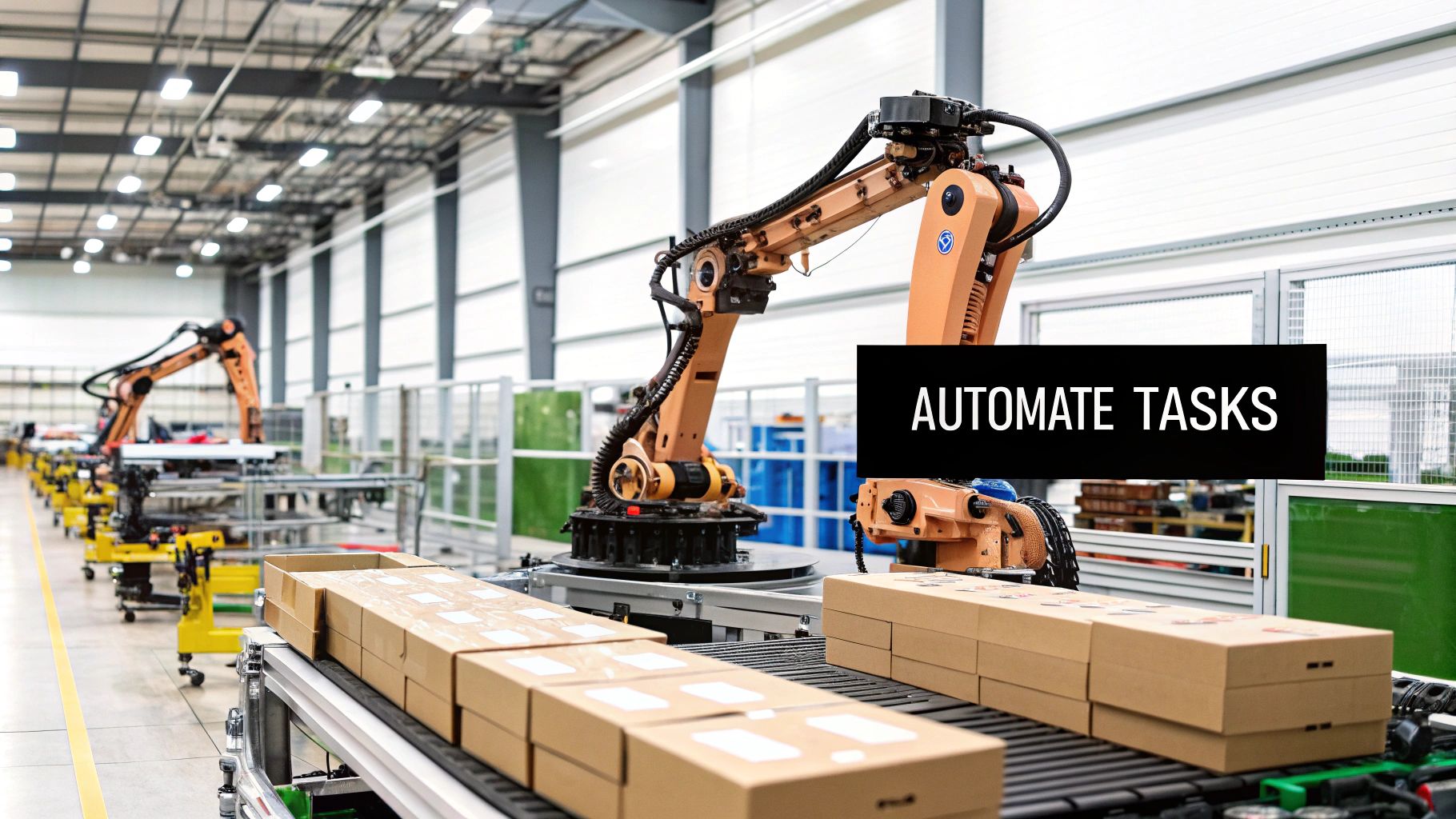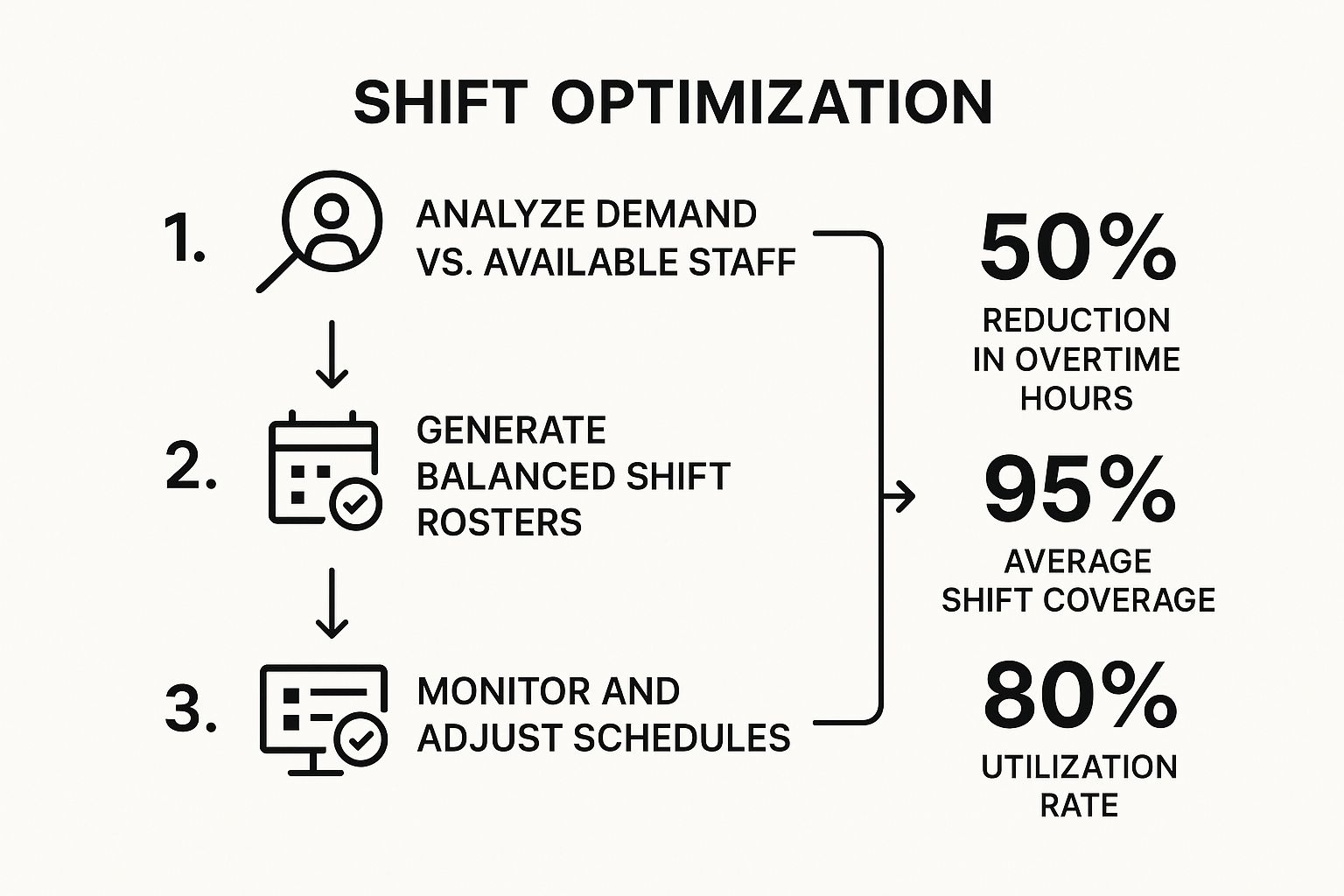Tired of hearing the same old advice about cutting labor costs? The kind that usually involves slashing hours and hurting team morale? There's a much smarter way to approach this.
The real solution is found in three key areas: strategic automation, intelligent workflow optimization, and flexible workforce management. This isn't about just trimming the fat; it's about making every single dollar you spend on labor work harder and more efficiently for you.

The old way of thinking about labor costs was a zero-sum game. To save money, you had to cut people or their hours. Simple, but brutal.
Today's approach is completely different. It’s all about amplifying your team's impact with the right technology and smarter processes. The goal is to turn your labor line item from a simple expense into a powerful, efficient engine for growth.
This modern playbook is about creating a system where your team gets more done in less time. You free them from the repetitive, low-value work so they can focus on the things that actually matter—like growing the business and delighting your customers.
A huge driver behind this shift is the easy access we now have to powerful, affordable tech. We've seen countless businesses that invest in automation—things like AI, smart software, and other digital tools—successfully slash the time spent on routine manual tasks.
This allows them to either move team members to higher-value activities or absorb rising wage pressures without breaking the bank. Over time, these small changes lead to some seriously significant reductions in labor expenses.
Here are a few practical, tech-driven solutions you can implement right now:
The core idea is simple: By automating repetitive tasks, you empower your employees to focus on strategic work that drives revenue and enhances customer satisfaction. This directly contributes to a leaner, more effective operation.
To give you a clearer picture, here’s a quick breakdown of these strategies.
These methods aren't just about saving money in one department; they create a ripple effect of efficiency across your entire business.
Many of these same principles can be applied to a broader strategy to reduce operational costs, proving just how interconnected these efficiency gains really are. Think of this guide as your roadmap to building a more resilient and profitable business by smartly managing your most valuable resource—your team.
Cutting hours or freezing hiring feels like the most direct way to slice your labor costs. But honestly, it's a short-term fix. A much more powerful—and sustainable—strategy is to get more value out of every hour your team already works.
The real win isn't just about trimming expenses; it's about boosting your team's productivity. When your crew can accomplish more in the same amount of time, your unit labor cost—what it costs you in labor to produce one item or deliver one service—plummets.
This flips the script. Instead of asking, "How can we spend less?" you start asking, "How can we achieve more with what we have?" The answers almost always point toward fine-tuning your internal processes, offering smart training, and setting clear performance goals that actually motivate people.
Take a step back and just watch your daily operations for a bit. Where are the hang-ups? Where does work grind to a halt? You'd be amazed how small, simple tweaks to your workflow can unlock huge time savings.
I saw this firsthand with a retail store that was struggling with long restocking times. Their solution? They simply rearranged the stockroom to put the fastest-selling items closer to the sales floor. That one change cut their restocking time by 30%. Now, staff spends less time in the back and more time on the floor helping customers, which directly boosts efficiency and sales. No fancy tech needed.
Or think about a small marketing agency where projects always seem to get stuck in the review and approval stage. Instead of endless, confusing email chains, they could set up a shared project board with a tool like Trello or Asana. Centralizing feedback gets approvals done way faster.
The goal here is simple: find and eliminate the "friction" in your daily tasks. Every minute you save on a clunky process is a minute your team can spend on activities that actually make you money.
Putting money into your team's skills is a direct investment in your bottom line. This doesn't mean you have to send everyone to expensive, week-long seminars. Often, the most effective training is quick and targeted to the specific tools and processes you use every single day.
A few ideas to get you started:
This isn't just a hunch; the numbers back it up. The U.S. Bureau of Labor Statistics has long shown that higher productivity directly lowers unit labor costs, helping businesses handle rising wages without cutting staff. You can dive into the economic data yourself to see the trends. It all points to the same conclusion: investing in your team's efficiency is one of the smartest financial moves you can make.

Alright, let's move from theory to action. It’s one thing to spot your most repetitive tasks, but real progress starts when you bring in technology to do that work for you. For a lot of small business owners, the idea of AI and automation sounds complicated and expensive, but that’s just not the reality anymore.
Modern tools are built to be affordable, surprisingly easy to set up, and incredibly good at handling the time-sucking admin tasks that drain your resources. This is a direct line to cutting your labor costs without hurting—and often, actually improving—your customer experience.
Think about your front desk or the first point of contact for your customers. How many hours a day are spent just answering the same handful of questions, scheduling appointments, or directing calls? These jobs are crucial, but they are also incredibly repetitive. That makes them perfect candidates for automation.
An AI-powered receptionist can manage all of this 24/7, making sure you never miss another lead or an important client call. It can field frequently asked questions, book appointments right into your calendar, and even know when to pass a complex issue to a human team member.
This one piece of technology can do the work of a part-time or even a full-time employee, but for a tiny fraction of the cost. To get a feel for how it all works, you can explore what an AI receptionist for small businesses can do and picture how it fits into your daily routine. It's one of the fastest ways to see a real, tangible return on your investment.
Beyond the front desk, automation can completely overhaul your back-office and marketing work, which are often packed with hidden labor costs.
Automated Invoicing and Payroll: Doing invoices and payroll by hand isn't just slow; it’s a recipe for costly mistakes. Modern systems can automatically create and send invoices, chase up payments, and handle payroll with all the necessary tax and deduction calculations. The hours saved here are enormous.
Marketing and Lead Nurturing: Instead of manually sending follow-up emails, you can build automated sequences. Imagine a new lead fills out a form on your website—the system can instantly send a welcome email, followed by a series of helpful messages over the next few weeks, all on its own.
A study revealed that businesses lose trillions of dollars every single year to lost productivity from tasks that could be automated. This just shows the massive opportunity you have to shift your team's focus from manual "busy work" to strategic, revenue-generating activities.
Specialized tools can take this even further. Beyond general automation, specific solutions like accounting AI can revolutionize your financial operations by taking over bookkeeping, expense tracking, and financial reporting with very little human input.
The key is to just get started. Pinpoint one or two major time-sinks in your business right now. Find a dedicated, affordable tool built to solve that exact problem. Once you see the immediate benefits, you'll build momentum and start spotting more and more opportunities to put smart tech to work, steadily chipping away at your labor expenses.
Inefficient workflows are a silent killer of productivity. They're the hidden source of labor costs that quietly bleed your budget dry. Think of all the little friction points in your daily operations—small delays, redundant tasks, and confusing processes. Individually, they seem minor, but together they add up to hours of wasted employee time every single week.
Finding and fixing these operational bottlenecks is one of the smartest ways to lower your labor expenses without having to let anyone go.
It all starts with a simple "workflow audit." You don't need fancy software—a pen and paper will do just fine. Pick a core process in your business and map it out from start to finish. For instance, a small contractor could trace the entire journey of a customer quote, from the initial phone call all the way to sending the final proposal.
Where do things get bogged down? Does information get lost when it's passed between team members? Are you still manually punching the same data into three different systems? These are the exact spots you need to target for improvement.
Once you have a process mapped out, it's time to trim the fat using a few ideas from lean management. The core concept is simple: get rid of any step that doesn't add real value for your customer or improve the final product.
Let's imagine a busy café struggling with its morning rush. After a quick audit, the owner realizes the baristas are constantly walking back and forth to a single computer to enter orders. This creates a huge bottleneck right when they need to be fastest.
A tiny tweak, like adding a second order-entry tablet next to the espresso machine, could eliminate all that wasted motion. This single change lets them serve more customers in the same amount of time with the same number of staff. Just like that, the labor cost per transaction drops.
If you're looking for tools to help with this, our guide on the 10 best workflow automation tools for small businesses is a great place to start.
Standardizing tasks is another powerful way to get more efficient. It just means creating one "best way" to do a common activity and making sure everyone on the team follows it. This consistency is a triple win: it reduces errors, slashes training time for new hires, and makes your results more predictable.
You can document these as Standard Operating Procedures (SOPs) in a shared folder or, even better, use visual tools to make them crystal clear.
A visual workflow helps everyone on the team see how their part fits into the bigger picture. When processes are clear and standardized, tasks get done faster and with fewer mistakes, which is a direct path to cutting down on unnecessary labor hours.
Tools like Trello or Asana are fantastic for making your workflows visible to the whole team. You can set up boards where each task is a card that moves from a "To-Do" column to "In Progress" and finally to "Complete." This kind of transparency shows everyone where projects stand and stops people from accidentally doing the same work twice.
This infographic breaks down how optimizing even a single process, like shift scheduling, can deliver some serious savings.

As you can see, taking a systematic approach to analyzing, balancing, and adjusting your workflows can dramatically cut down on wasted resources like overtime hours while making sure you always have the right people on the clock.

Getting a handle on labor expenses isn't about making drastic, across-the-board cuts. It’s about smart, strategic workforce management. It really boils down to optimizing your most valuable asset—your people. The biggest wins I’ve seen come from aligning staffing levels precisely with business demand, creating a team that’s both lean and incredibly effective.
This means you have to stop guessing. Reactive scheduling, where you're just throwing bodies at a shift, has to go. Instead, you need to lean into a more data-driven approach.
Look at your business patterns. When are your peak hours? When do things consistently slow down? Answering these questions with hard data is the first step toward building schedules that prevent both wasteful overstaffing and the kind of understaffing that kills service and frustrates customers.
One of the most powerful moves you can make is to cross-train your employees. When your team members can wear multiple hats, your business gains an amazing amount of flexibility.
Think about it: a cashier who can also stock shelves during a slow period or a receptionist who can handle basic social media updates turns expensive downtime into productive time.
This versatility creates an agile team that can pivot on a dime. When someone calls in sick, you're not scrambling to pay overtime or call in an expensive temp. You can cover more ground with a smaller, more capable team, which directly chips away at your payroll while keeping the business running smoothly.
The real secret of a cross-trained team is resilience. You're no longer dependent on a single person for a critical task, which minimizes disruptions and makes your labor budget much more stable and predictable.
Here’s a hard truth: not every role needs to be a 40-hour-a-week, permanent position. Embracing flexible staffing is a game-changer for managing fluctuating workloads without the high overhead of another full-time hire. This is especially true for businesses with seasonal peaks or project-based work.
Consider these flexible options:
This approach is at the heart of modern workforce strategy. With economic uncertainty, more and more businesses are using flexible staffing to tie labor costs directly to revenue. You can read more about how firms are balancing labor expenses with operational needs through these exact methods.
Finally, remember that a leaner team has to be a motivated one. As you optimize your staff, you can’t let standards slip or morale tank. A clear performance management system is your best friend here.
Regular check-ins and clear goals make sure every team member knows how they contribute and stays engaged. This focus on performance ensures that even with a streamlined crew, your quality and customer service never suffer.
After all, an efficient team is only truly cost-effective if it’s still delivering fantastic results.
Diving into automation and workflow optimization can feel like a big leap. It's totally normal for business owners to have questions about the impact on their team, the upfront cost, and frankly, where to even start. Let's get into some of the most common concerns I hear and offer some straight-up, practical answers.
Not at all. For the vast majority of small businesses, this is one of the biggest misconceptions. Automation isn't about replacing your people; it's about making them more powerful.
Think of it like this: by automating the repetitive, low-impact tasks—like answering the same phone questions over and over, manual data entry, or appointment scheduling—you're freeing up your team's brainpower. They can now shift their focus to the high-value work that really needs a human touch. This could be anything from building stronger relationships with your best customers to tackling complex problems or contributing to your business's growth strategy.
In fact, automation often allows you to handle more business without having to increase your headcount. That's a huge win for reducing your labor cost as a percentage of your revenue.
The goal isn't to eliminate jobs; it's to enhance your team's capacity. You're empowering the people you already have to do more, which is a massive boost for both productivity and morale.
Before you spend a dime or sign up for any software, start with a simple time and task audit. Seriously, just for one week, have your team (and yourself!) track where every hour goes.
Get specific. Are you losing hours every week to manual invoicing? Is your front desk person constantly tied up answering the same three questions from callers? This data becomes your treasure map. It gives you a clear, evidence-based picture of your biggest time sinks and operational bottlenecks.
Once you’ve pinpointed the most time-consuming, mind-numbing task, you’ve found your starting point. Look for one specific tool or process change to fix that one thing. This approach gets you a quick win, proves the concept to you and your team, and builds the momentum you need to tackle the next thing.
It’s easy to look at some of the giant, enterprise-level systems and think this stuff is out of reach. But the market has exploded with powerful, affordable tools built specifically with small businesses in mind. Many of the most effective automation tools run on a simple subscription model that costs less per month than a few hours of an employee's salary.
The real key is to shift your thinking to the return on investment (ROI). If a $50/month tool saves your team 10 hours of administrative work, it’s already paid for itself many, many times over.
Start small. Take advantage of free trials or low-cost plans to see the benefits for yourself before you commit to anything major. To get even more granular with your cost management, it's also worth exploring effective strategies for managing absenteeism to reduce costs, as this can also have a surprising impact on your bottom line.
Ready to see how a small investment can deliver huge returns? My AI Front Desk can automate your customer calls and appointment booking 24/7, freeing up your team and capturing every lead. Start your free trial and watch your efficiency soar.
Start your free trial for My AI Front Desk today, it takes minutes to setup!








